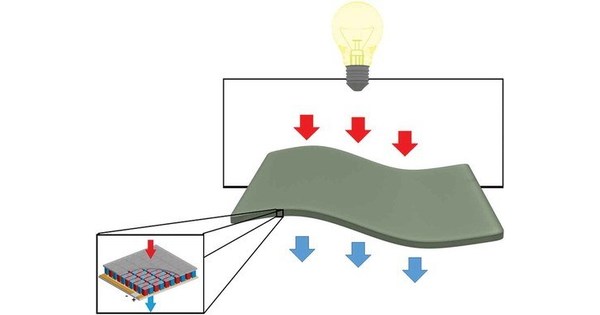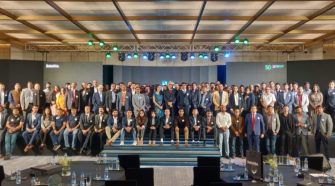TSUKUBA, Japan, Jan. 26, 2021 /PRNewswire/ — Technology for thermoelectric energy harvesting will play a central role in powering millions of sensors and devices for IoT applications especially for wearable electronics. This STAM review paper described the potential of state-of-the-art organic and inorganic thermoelectric materials to convert heat into electricity through the Seebeck effect for applications that include power mobile sensors powered by body heat.
A review article written by Takao Mori of NIMS and his colleagues published in Science and Technology of Advanced Materials in 2018 [1] gives a comprehensive overview of the “principles and advances in the development of thermoelectric materials suitable for energy harvesting power generation, ranging from organic and hybrid organic–inorganic to inorganic materials”. The review article has been awarded the 2020 STAM Best Paper Award.
Research on thermoelectric materials by Takao Mori and colleagues
For the past 15 years Mori’s research has focussed on thermoelectric materials, “which I think ideally is a very multidisciplinary field combining physics, chemistry, and materials science,” says Mori.
Thermoelectric materials convert waste heat to electricity through the Seebeck effect, and Mori’s goals are to develop high performance materials for energy saving and added-value power supply through conversion of waste heat, which is the topic of this STAM paper, that covers thermoelectric energy harvesting for powering IoT (Internet of Things) sensors and devices for ‘Society 5.0’.
Notably, certain paradoxes must be resolved for high thermoelectric performance, such as developing materials that conduct electricity but block thermal transport, and exhibit large Seebeck coefficients like insulators but also high metal-like electrical conductivity. “Our goals are to discover and develop new principles to overcome these paradoxical material requirements,” says Mori. “Recently we have developed novel principles, such as utilization of nanopores for highly effective selective scattering of phonons, utilizing magnetism. Here magnetic interactions and spin fluctuations significantly enhance thermoelectric properties of the materials. As a result, we have realized new high performance thermoelectric materials.”
Areas covered in the award winning STAM paper by Mori and colleagues
For many years, the main goals of research on thermoelectric power generation have been mid to high temperature range waste heat conversion for application to cars. However, recent advances in IoT technology, such as flexible electronics for wearable sensors, has led some researchers to change their direction to focus on thermoelectric energy harvesting power generation for IoT sensors.
“Regarding the contents of this paper, our main activities at the time were on thermoelectric energy harvesting using inorganic thermoelectric materials that have an advantage in thermoelectric performance,” explains Mori. “As a co-author, I invited Professor Xavier Crispin of Linkoping University, Sweden, to write the paper together with me, since he is one of the leading researchers in the world on flexible organic/polymer thermoelectric materials, and he discovered the recent large jump in the performance of such materials, which were considered quite low performance until then.”
Mori also included several young authors from both groups, and “the NIMS group wrote the part on the developments of organic-inorganic hybrid and inorganic materials and devices.”
He adds that he decided to also cover inorganic materials in this review so as to be useful and inspiring to researchers of all fields in thermoelectrics.
“Both our group members, Dr. Petsagkourakis, Dr. Tybrandt, Dr. Satoh, and Dr. Ohkubo, very actively contributed to the writing of the paper, and of course, Prof. Crispin and I decided the many individual topics/materials/devices to cover, and ultimately were responsible for the final writing of the review, and I serve as the corresponding author,” Mori.
On receiving the 2020 STAM Journal’s Best Paper Award, Mori said: “STAM is one of the world’s major journals covering materials science and it is a great honor for all the authors of the paper to receive this award. It also made me very happy that the field I am in, thermoelectrics, has been recognized in this way.”
Views about STAM
Mori says that STAM is particularly active in organizing focused issues on interesting topics in materials science. “The journal covers both hot topics, which should indeed be covered, but also traditionally important areas of research. The focused issues are important for promoting such topics where the inclusion of reviews and primary research articles are valuable resources for newcomers.”
Reference
[1] Ioannis Petsagkourakis , Klas Tybrandt , Xavier Crispin , Isao Ohkubo , Norifusa Satoh and Takao Mori, Thermoelectric materials and applications for energy harvesting power generation, Science and Technology of Advanced Materials, 2018, 19, NO. 1, 836–862 https://doi.org/10.1080/14686996.2018.1530938
Further information about press release:
Science and Technology of Advanced Materials (STAM) Headquarters Office, National Institute for Materials Science (NIMS)
Address: 1-2-1 Sengen, Tsukuba 305-0047
EMAIL: [email protected]
About NIMS and STAM
NIMS and Empa have jointed efforts to develop a flagship journal that provides highly-quality information on recent developments in materials science within an open access platform. The collaboration will strengthen the position of STAM in Europe.
SOURCE Science and Technology of Advanced Materials (STAM) Headquarters Office










_(1)_(1)-225x125.jpg)







